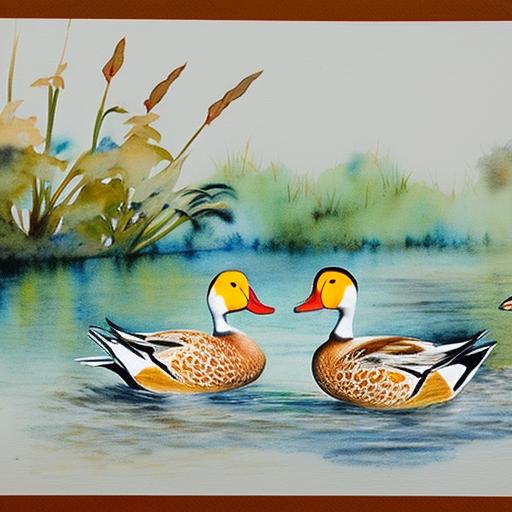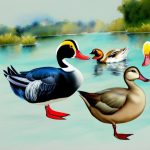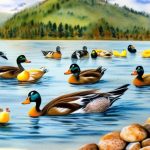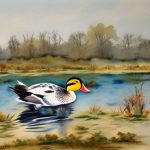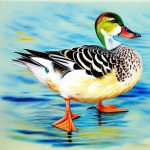Duck breeding season is a crucial time in the life cycle of ducks, as it is the period when they engage in courtship, mating, and nesting activities. This season typically occurs in the spring and early summer months, when the weather is warmer and food sources are more abundant. During this time, male ducks, known as drakes, engage in elaborate courtship displays to attract females, while females, known as hens, search for suitable nesting sites to lay their eggs. Once the eggs are laid, the female duck will diligently incubate them until they hatch, at which point she will care for and protect her ducklings.
Duck breeding season is a natural and instinctual process that is essential for the survival and continuation of duck populations. It is a time of heightened activity and energy for ducks, as they focus on finding mates, building nests, and raising their young. Understanding the behaviors and patterns associated with duck breeding season is important for conservation efforts and for those who wish to observe and appreciate these fascinating creatures in their natural habitat.
Key Takeaways
- Duck breeding season typically occurs in the spring and early summer, when ducks are most active in finding mates and nesting sites.
- Signs of duck breeding season include increased vocalization, courtship displays, and the formation of pairs or small groups.
- Environmental factors such as water availability, food sources, and suitable nesting sites can greatly impact duck breeding success.
- Duck breeding season is important for maintaining healthy duck populations and ecological balance in wetland ecosystems.
- Conservation efforts during duck breeding season focus on protecting nesting sites, managing habitat, and minimizing disturbances to nesting ducks.
Signs of Duck Breeding Season
There are several signs that indicate the arrival of duck breeding season. One of the most noticeable signs is the increased activity and vocalization of male ducks as they engage in courtship displays to attract females. These displays often involve elaborate movements, such as head bobbing, tail wagging, and wing flapping, as well as vocal calls to announce their presence and availability to potential mates.
Another sign of duck breeding season is the presence of nesting behavior, as female ducks search for suitable sites to build their nests and lay their eggs. This may involve the female duck creating a shallow depression in the ground or finding a secluded spot near water to construct her nest. Once the nest is built, the female will lay her eggs and begin the process of incubation, during which she will sit on the eggs to keep them warm and protected.
Additionally, the sight of ducklings following their mother is a clear indication that duck breeding season has been successful. These adorable young ducks are often seen swimming alongside their mother as she teaches them how to forage for food and navigate their environment. These signs of duck breeding season are a delight to observe and serve as a reminder of the beauty and wonder of nature.
Environmental Factors Affecting Duck Breeding Season
Several environmental factors can impact duck breeding season, including temperature, water availability, and food sources. Warmer temperatures in the spring and early summer months signal the arrival of breeding season for ducks, as it provides ideal conditions for courtship, nesting, and raising young. Additionally, the availability of water is crucial for ducks during breeding season, as they require access to ponds, lakes, or other bodies of water for mating rituals and for providing a habitat for their young.
The presence of suitable food sources is also essential for ducks during breeding season, as they need to maintain their energy levels for courtship displays, nesting activities, and caring for their offspring. A lack of food can negatively impact duck breeding success and survival rates for ducklings. Human activities and habitat destruction can also have a significant impact on duck breeding season, as it can disrupt nesting sites and reduce available food sources.
Conservation efforts aimed at preserving natural habitats and ensuring the availability of clean water and abundant food sources are crucial for supporting healthy duck populations during breeding season. By understanding and addressing these environmental factors, we can help ensure the success of duck breeding season and the long-term sustainability of duck populations.
Importance of Duck Breeding Season
Duck breeding season plays a vital role in maintaining healthy duck populations and preserving biodiversity in ecosystems. During this time, ducks contribute to the dispersal of seeds and nutrients through their foraging activities, which helps to support the health of wetland habitats. Additionally, ducks serve as important prey species for predators, helping to maintain balance within food webs.
Furthermore, duck breeding season provides opportunities for scientific research and monitoring of duck populations, which can help inform conservation efforts and management strategies. By understanding the behaviors and needs of ducks during breeding season, conservationists can work to protect critical habitats and address threats to duck populations.
Duck breeding season also offers educational opportunities for people to learn about the natural world and appreciate the beauty of these remarkable birds. Observing ducks during breeding season can inspire a sense of wonder and curiosity about the complexities of nature and the interconnectedness of all living things. By recognizing the importance of duck breeding season, we can work to ensure that ducks continue to thrive in their natural environments for generations to come.
Duck Breeding Season and Conservation Efforts
Conservation efforts play a crucial role in supporting healthy duck populations during breeding season. One key aspect of conservation is the protection and restoration of wetland habitats, which are essential for providing suitable nesting sites and food sources for ducks. Wetlands also serve as important stopover points for migratory ducks, making them critical for supporting diverse duck populations.
In addition to habitat conservation, efforts to reduce pollution and mitigate human impacts on water quality are essential for supporting healthy duck populations during breeding season. Clean water is vital for ducks, as it provides a source of food and a habitat for courtship displays and raising young. By addressing pollution and habitat degradation, conservationists can help ensure that ducks have access to the resources they need to thrive during breeding season.
Furthermore, conservation efforts can involve monitoring duck populations through surveys and research to assess population trends and identify potential threats. This information can help inform management decisions and conservation strategies aimed at protecting ducks during breeding season and throughout the year. By working together to support conservation efforts, we can help ensure that duck breeding season remains a time of vitality and success for these remarkable birds.
Managing Duck Breeding Season on Farms and in Urban Areas
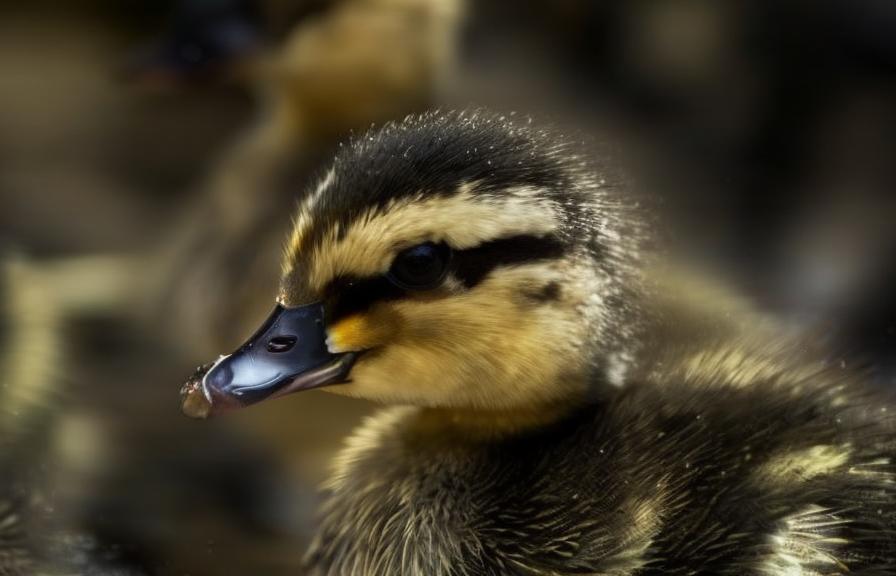
In agricultural areas, it is important to consider how duck breeding season may intersect with farming practices. Farmers can take steps to minimize disturbances to nesting sites by avoiding mowing or tilling fields during this time. Creating buffer zones around wetlands and water bodies can also help protect nesting sites from human disturbances.
In urban areas, efforts to preserve green spaces and natural habitats can provide important nesting sites for ducks during breeding season. Protecting water quality in urban ponds and lakes is also crucial for supporting healthy duck populations. Educating the public about the importance of preserving natural habitats can help foster a sense of stewardship for urban wildlife, including ducks during breeding season.
By implementing management practices that consider the needs of ducks during breeding season, we can help support healthy populations in both agricultural and urban landscapes. This can contribute to the overall conservation of ducks and their habitats while promoting coexistence between humans and wildlife.
Tips for Observing Duck Breeding Season in the Wild
For those interested in observing duck breeding season in the wild, there are several tips to keep in mind to ensure a positive experience for both humans and ducks. First and foremost, it is important to maintain a respectful distance from nesting sites and avoid disturbing ducks during this sensitive time. Using binoculars or a camera with a telephoto lens can allow for close observation without intruding on nesting areas.
Visiting wetland habitats or bodies of water where ducks are known to breed can provide opportunities to observe courtship displays and nesting behaviors. Early morning or late afternoon are often good times to observe ducks when they are most active. Patience is key when observing wildlife, as it may take time to witness specific behaviors associated with duck breeding season.
It is also important to be mindful of leaving no trace when visiting natural areas where ducks breed. This includes properly disposing of trash and avoiding any actions that could harm or disrupt wildlife. By following these tips, individuals can enjoy observing duck breeding season while minimizing impacts on these remarkable birds.
In conclusion, duck breeding season is a time of heightened activity and importance for ducks as they engage in courtship displays, nesting behaviors, and raising their young. Understanding the signs of duck breeding season, environmental factors that impact it, its importance in conservation efforts, and how to manage it in different landscapes are all crucial aspects of supporting healthy duck populations. By observing these remarkable birds with respect and appreciation in their natural habitats, we can gain a deeper understanding of their behaviors and contribute to their long-term conservation.
If you’re interested in learning more about poultry breeding, you might also want to check out this informative article on how many eggs geese lay. It provides valuable insights into the egg-laying habits of geese and can be a helpful resource for anyone considering raising geese for their eggs.
FAQs
What is duck breeding season?
Duck breeding season refers to the time of year when ducks engage in courtship and mating behaviors in order to reproduce and raise their young.
When does duck breeding season occur?
Duck breeding season typically occurs in the spring and early summer months, varying slightly depending on the specific species of duck and their geographic location.
What are the signs of duck breeding season?
During duck breeding season, male ducks may display more vibrant plumage and engage in elaborate courtship displays to attract females. Female ducks may also exhibit behaviors such as nest-building and increased vocalization.
How long does duck breeding season last?
Duck breeding season can last for several weeks to a few months, depending on the species and environmental factors. Once mating has occurred, female ducks will begin nesting and incubating their eggs.
Why is it important to be aware of duck breeding season?
It is important to be aware of duck breeding season in order to minimize disturbances to nesting ducks and their young. Disturbances during this critical time can lead to nest abandonment and reduced reproductive success for duck populations.
Meet Walter, the feathered-friend fanatic of Florida! Nestled in the sunshine state, Walter struts through life with his feathered companions, clucking his way to happiness. With a coop that’s fancier than a five-star hotel, he’s the Don Juan of the chicken world. When he’s not teaching his hens to do the cha-cha, you’ll find him in a heated debate with his prized rooster, Sir Clucks-a-Lot. Walter’s poultry passion is no yolk; he’s the sunny-side-up guy you never knew you needed in your flock of friends!

